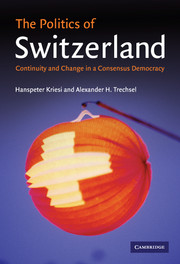Book contents
- Frontmatter
- Contents
- List of figures
- List of tables
- Preface
- List of abbreviations
- 1 The development of the modern Swiss nation-state
- 2 Neutrality
- 3 Federalism
- 4 Direct democracy
- 5 The Swiss system of government
- 6 The party system
- 7 Interest associations and labour relations
- 8 The decision-making process
- 9 Economic policy: liberalization under constraints
- 10 Social policy: the Swiss welfare state
- 11 Foreign policy: Switzerland and the EU
- Appendix
- References
- Index
7 - Interest associations and labour relations
Published online by Cambridge University Press: 05 September 2012
- Frontmatter
- Contents
- List of figures
- List of tables
- Preface
- List of abbreviations
- 1 The development of the modern Swiss nation-state
- 2 Neutrality
- 3 Federalism
- 4 Direct democracy
- 5 The Swiss system of government
- 6 The party system
- 7 Interest associations and labour relations
- 8 The decision-making process
- 9 Economic policy: liberalization under constraints
- 10 Social policy: the Swiss welfare state
- 11 Foreign policy: Switzerland and the EU
- Appendix
- References
- Index
Summary
Introduction
Swiss interest associations have traditionally been very important actors in Swiss politics. Their powerful position contrasts with the weakness of Swiss political parties. Interest associations have been more coherently structured and more resourceful than parties and they have traditionally played a key role in the legislative process in the pre-parliamentary arena as well as in policy implementation. Switzerland has therefore often been considered as a paradigmatic case of democratic corporatism. Thus, Peter Katzenstein (1985), who analysed how the small Western European countries met the challenge of their integration into global markets, counted Switzerland among the typical cases of ‘democratic corporatism’. Three elements characterized this kind of regime: a centralized and concentrated system of interest associations; a voluntary and informal coordination of the various interests in continuous political negotiations between their associations, political parties and the various branches of public administration; and an ideology favouring social partnership. Based on the configuration of power in the system of interest intermediation, Katzenstein distinguished between two versions of ‘democratic corporatism’ – a liberal and a social version. In the social version, typically represented by Sweden, a strong labour movement was capable of matching the power of the business community. In the liberal version, for which Switzerland represented the typical case, power was asymmetrically distributed between a dominant business community and a rather weak labour movement.
- Type
- Chapter
- Information
- The Politics of SwitzerlandContinuity and Change in a Consensus Democracy, pp. 99 - 114Publisher: Cambridge University PressPrint publication year: 2008



